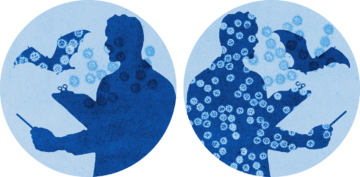Maggie Koerth in FiveThirtyEight:
 “In North America we pose a far greater risk to our bats than they do to us,” said O’Keefe, a bat ecologist and professor of environmental science at the University of Illinois at Urbana-Champaign. COVID-19 is a zoonotic disease, an illness that jumped from animal hosts to humans. But disease transfer isn’t just a one-way street. It takes only a bit of evolutionary bad luck to turn a bat’s head cold into a human’s killer. But it takes only a little more for the same virus to jump from humans to other animals. Zoonosis begets reverse zoonosis, which can, in turn, come back around to zoonosis again. A virus we give to a bat could, someday, come back around to reinfect us. Animals’ health is ours, ours is theirs, theirs is ours.
“In North America we pose a far greater risk to our bats than they do to us,” said O’Keefe, a bat ecologist and professor of environmental science at the University of Illinois at Urbana-Champaign. COVID-19 is a zoonotic disease, an illness that jumped from animal hosts to humans. But disease transfer isn’t just a one-way street. It takes only a bit of evolutionary bad luck to turn a bat’s head cold into a human’s killer. But it takes only a little more for the same virus to jump from humans to other animals. Zoonosis begets reverse zoonosis, which can, in turn, come back around to zoonosis again. A virus we give to a bat could, someday, come back around to reinfect us. Animals’ health is ours, ours is theirs, theirs is ours.
For North American bats, contracting this new virus carried the risk of absolute annihilation. Unlike Old World bats, they aren’t natural reservoirs for the branch of the coronavirus family that includes SARS-CoV-2 (the official name of the novel coronavirus), so they have no preexisting immunity to it. And spring was a crucial time. COVID-19 reached the U.S. just as bats were waking from winter hibernation and humans were gearing up for bat research season. The people on that March conference call knew that, within weeks, human researchers would begin catching bats — weighing them, measuring them, literally breathing directly into their tiny faces. We barely knew where COVID-19 had come from, and already we had to think about what it might spread to next.
The bats weren’t — and still aren’t — the only animals of concern. Even now, a year later, researchers are still working to figure out which animals, in which places, are most at risk. It’s a question that has consequences for both animals and people. Every new species that becomes a host for COVID-19 is also a population where the virus can change, mutate, and boomerang back to us. Bats are a bellwether, an example of how our relationships with animals can threaten both our health and theirs.
More here.
